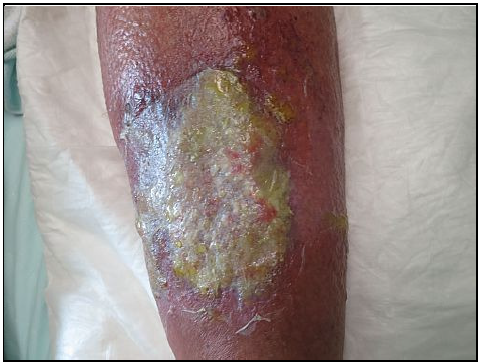Case Presentation: A 53 year old man with uncontrolled diabetes type 2, hypertension, obese, stage III chronic kidney disease, chronic lower extremity edema with venous stasis, and recurrent lower extremity cellulitis was admitted to a large Quaternary medical center with 2 days of fever, chills, left lower extremity swelling, redness and pain. Started when he was kayaking in a lake in northern Wisconsin. Patient denied gastrointestinal symptoms. Physical exam revealed a temperature of 102 F, blood pressure of 160/80 mmHg, heart rate of 80/min and respiratory rate of 14/min. His left leg was tender, swollen, and erythematous with changes of chronic venous stasis. There were 3×3 cm blisters with clear content on the anterior aspect of the lower extremity (see pictures). Labs done revealed a white blood cell count of 13,200/mm3 with left shift, platelets of 150,000/mm3. Creatinine of 1.5 mg/dL, HbA1C 8.0% and glucose of 180 mg/dL., liver function tests and coagulation panel were normal. Patient was started on cefazolin, vancomycin and levofloxacin. Then therapy was consolidated to vancomycin and cefepime. Blood and wound cultures grew non-01 V. cholerae susceptible to ampicillin, tetracycline and cotrimoxazole. Diagnosis was confirmed by the state laboratory. Antibiotics were changed to ampicillin-sulbactam and doxycycline for two more weeks. Topical wound care was applied and no debridement was required. Wound improved after one week of antibiotic therapy.
Discussion: Vibrio cholera is a Gram negative, “comma” shaped, facultative anaerobe, non-spore-forming rod, polar flagellated, motile bacteria, found in brackish and saltwater. Non-O1 V. cholerae has been associated with systemic infection, such as septicemia, skin and soft tissue infection, pneumonia, sinusitis, peritonitis, and biliary tract infection , mainly in immunocompromised host or patients with underlying liver disease, causing severe wound infections or sepsis, with high mortality rates. For clinicians, this article alerts to the importance of suspecting unusual pathogens, mainly in vulnerable populations (e.g. immunocompromised host, elderly, co-morbidities), in the ones who do not improve with standard antibiotic therapy or in cases where there is no microbiological diagnosis with conventional techniques and cultures. We also consider a possible link of the world climate change and the colonization of new environments by this microorganism. Baker-Austin et al have expressed increasing concern regarding the role of climate change in driving bacterial waterborne infectious diseases and remarked the importance of Vibrio risk at high latitudes in response to ocean warming.
Conclusions: We report a unique case of cellulitis and Sepsis by Non-O:1 Vibrio cholerae contracted by a 53-year-old Caucasian male without underlying risk factors, exposed to freshwater sporting activities in Northern Wisconsin. This rare case of Non-O:1 cholera infection in the United States and was linked to freshwater lake exposure that in turn can be related to climate change and global warming. A high index of suspicion is required for early diagnosis and appropriate management to avoid adverse outcomes. Further, this case also illustrates the need for Public health authorities to study the effects of world climate change on microbial behavior and their role in this and other emerging infectious diseases.

